Explore Matabeleland - Zimbabwe Travel, Africa
Explore Matabeleland - Zimbabwe Travel, Africa
Matabeleland, nestled in the southwest of Zimbabwe, is a region rich in culture, history, and natural wonders, offering a unique travel experience. Known for its connection to the Ndebele people and its stunning landscapes, this destination offers a blend of heritage and adventure. From the awe-inspiring Victoria Falls to the wildlife-filled plains of Hwange National Park, Matabeleland is the perfect getaway for travelers seeking Zimbabwe’s vibrant history and experiencing authentic African culture.
Population: Approximately 2.6 million in 2022.
Economy: Matabeleland's economy is driven by agriculture, mining, and tourism, with industries such as cattle ranching, gold mining, and nature-based tourism contributing significantly to regional growth.
Landmarks: Famous for the Victoria Falls, Hwange National Park, and the Matobo Hills.
Zimbabwe
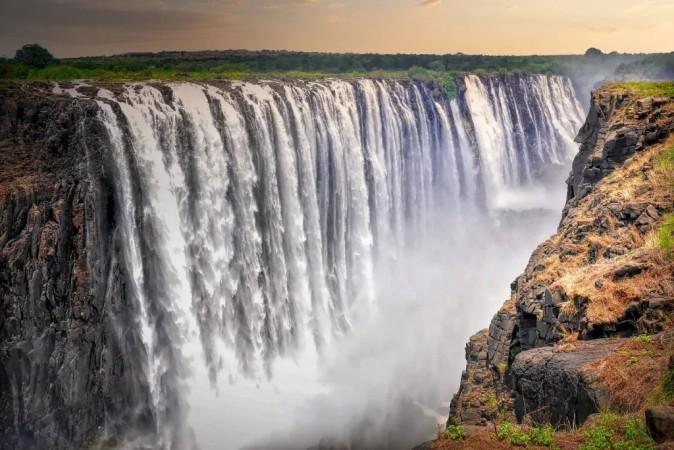
Overview of Matabeleland
History & Cultural Influence
Matabeleland’s history is deeply tied to the Ndebele people, who settled here in the 19th century after migrating from what is now South Africa. During the late 1800s, the Ndebele kingdom, led by King Lobengula, fiercely defended its territory against British colonization, resulting in the Matabele Wars. This historical backdrop is still evident today, as local traditions and customs reflect a strong sense of pride in the region’s cultural heritage. Visitors can explore colonial-era buildings that stand in contrast to traditional Ndebele homes, known for their colorful murals and circular designs. You can also visit historic sites such as King Lobengula’s ruins or engage in cultural tours to understand how the past shapes today’s way of life.
Interaction with the Locals
Matabeleland is home to a population of around 2.6 million people, predominantly from the Ndebele ethnic group, alongside other smaller groups such as the Shona and Kalanga. The citizens of Matabeleland are known for their rich cultural heritage, with the Ndebele people playing a central role in shaping the region’s identity. They speak Southern Ndebele as their primary language, though English is also widely spoken. The people are noted for their warmth and strong community ties, which reflect their deeply ingrained traditions and beliefs passed down through the years.
Victoria Falls - © The Sydney Morning Herald
Top Attractions in Matabeleland
Victoria Falls
No visit to Matabeleland is complete without seeing Victoria Falls, one of the world's seven natural wonders. The falls, called locally as Mosi-oa-Tunya ("The Smoke that Thunders"), are breathtaking, especially during the rainy season when the Zambezi River reaches its peak capacity. Adventure activities like white-water rafting and bungee jumping are available for thrill-seekers, while those looking for a peaceful experience can enjoy scenic boat cruises at sunset.
Hwange National Park
Home to one of the largest elephant populations in Africa, Hwange National Park offers a quintessential safari experience. Spanning over 14,000 square kilometers, the park is teeming with wildlife, including lions, zebras, giraffes, and the elusive African wild dog. Whether on a guided game drive or a walking safari, the park provides an unforgettable chance to observe wildlife in its natural habitat.
Matobo Hills
A UNESCO World Heritage site, Matobo Hills is a place of spiritual significance and natural beauty. The region is well-known for its balanced rock formations and ancient San rock art, some of which date back thousands of years. Matobo is also home to the final resting place of Cecil Rhodes, one of the most controversial figures in Zimbabwe’s colonial history. For hikers and history enthusiasts, this site is a must-visit.
Bulawayo
Matabeleland’s largest city, Bulawayo, is a blend of colonial charm and modern culture. Its wide streets and historical buildings give it a unique atmosphere. Visit the Natural History Museum to learn more about Zimbabwe’s past, or explore the Makokoba Market for a taste of local life. The city is also a gateway to many nearby attractions, including the Khami Ruins, another UNESCO site located just outside of town.
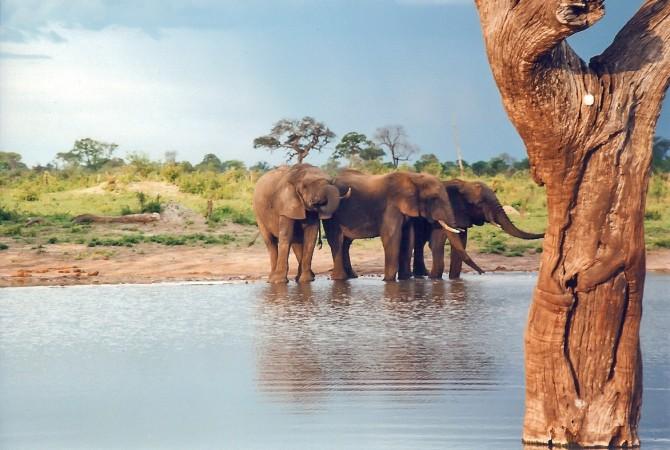
Hwange National Park - © Wikipedia
Must-Try Dishes in Matabeleland
Matabeleland cuisine reflects the region's rich cultural past as well as its natural riches. These dishes will give visitors a true taste of Matabeleland’s culinary traditions, deeply rooted in the land and culture of the region.
- Isitshwala: A staple dish, Isitshwala is made from maize meal and typically served with various stews or relishes. It’s enjoyed by most households and often paired with meat, vegetables, or legumes like beans and spinach.
- Sadza and Beef Stew: This is a popular traditional Zimbabwe meal across the country. The slow-cooked beef stew is rich in flavor, enhanced by tomatoes, onions, and local spices. Paired with sadza, it’s a comforting and satisfying dish commonly eaten during family gatherings.
- Umxhanxa: A seasonal dish made from pumpkin and maize, Umxhanxa is enjoyed particularly in rural areas. The ingredients are boiled together to create a sweet and filling dish, making it a unique part of the local cuisine.
- Tripe (Ulusu): Ulusu, or tripe, is a popular dish made from cow stomach. It’s slow-cooked with tomatoes, onions, and spices to create a tender and flavorful meal. It’s usually served with isitshwala and is beloved for its rich taste and texture.
- Amahewu (Fermented Maize Drink): Amahewu is a traditional fermented maize drink, often served as a refreshing beverage during meals or as a light snack. It has a slightly tangy taste and is enjoyed by locals as a thirst quencher, especially on hot days.
- Gizzards (Inhliziyo): Gizzards, or chicken hearts (inhliziyo), are a common street food in Matabeleland. Grilled or fried, they are often served as skewers, offering a tasty and protein-rich snack that pairs well with local sauces or relishes.
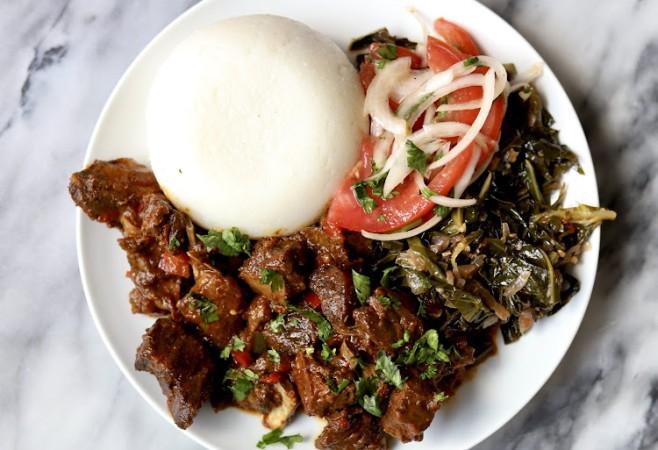
Sadza and Beef Stew - © The Star
Festivals & Local Celebrations
Matabeleland is a region alive with vibrant festivals and cultural celebrations, offering visitors a glimpse into the heart of Ndebele traditions. Participating in these festivals is a fantastic way to experience the local way of life.
Ndebele Cultural Festival
The Ndebele Cultural Festival, held yearly, is a vibrant celebration of the region's past. It features traditional dances, music, and art exhibitions that showcase the unique craftsmanship of the Ndebele people. Visitors may immerse themselves in the rich culture by seeing performances like the isitshikitsha dance.
Intwasa Arts Festival
Hosted in Bulawayo, the Intwasa Arts Festival brings together artists from all over Zimbabwe and beyond. This multi-disciplinary event includes music, theater, visual arts, and literary sessions. It’s a perfect opportunity for art lovers to engage with local creativity and enjoy Zimbabwean talent.
Mzilikazi Day
This annual commemoration celebrates the founding of the Ndebele nation by King Mzilikazi. The day is marked with traditional ceremonies, performances, and storytelling sessions that pay tribute to Ndebele history. It’s an important cultural event that attracts both locals and tourists.
Umthwentwe WaBantwana
A significant rite of passage, this celebration is held to honor boys transitioning into manhood in the Ndebele community. Although mainly a private ceremony, some parts of the event are open to visitors interested in learning about local customs and traditions.
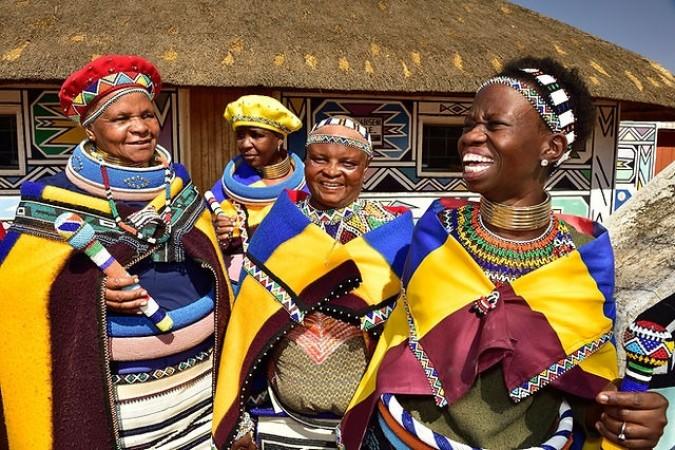
Ndebele Cultural Festival - © Wikimedia
What to Do in Matabeleland
- Safari Tours in Hwange National Park: For wildlife enthusiasts, Hwange National Park is a must-visit. Go on a guided safari to spot elephants, lions, and the African wild dog. The park offers both game drives and walking safaris, allowing visitors to get up close to the wildlife.
- Hiking in Matobo National Park: Hikers will love the trails in Matobo National Park, known for its granite rock formations and ancient San rock art. The park also offers a chance to see black and white rhinos, as well as the gravesite of Cecil Rhodes, perched atop a hill with sweeping views.
- Victoria Falls Adventure Sports: If you’re an adrenaline junkie, Victoria Falls offers activities like white-water rafting, bungee jumping, and helicopter tours. The falls are a UNESCO World Heritage site and provide one of the most awe-inspiring experiences in Africa.
- Bulawayo City Tour: For a mix of history and culture, take a city tour of Bulawayo. Visit landmarks such as the Bulawayo Railway Museum and the National Gallery of Zimbabwe. Stroll through bustling markets to shop for local handicrafts and souvenirs.
Shopping in Matabeleland
- Ndebele Beadwork and Pottery: Ndebele beadwork is world-renowned for its intricate patterns and vibrant colors. Visitors can purchase beaded jewelry, bags, and home décor. Handmade pottery, featuring traditional designs, is also widely available and makes for a meaningful souvenir.
- Bulawayo’s Makokoba Market: One of the oldest markets in the region, Makokoba Market in Bulawayo is the place to go for local produce, traditional clothing, and handmade crafts. It’s an excellent spot to mingle with locals while shopping for unique, handcrafted items.
- Arts and Craft Centers: Bulawayo has a number of arts and craft centers where local artisans sell their goods. The National Gallery of Zimbabwe in Bulawayo features a collection of local art, perfect for travelers looking to bring home original Zimbabwean artwork.
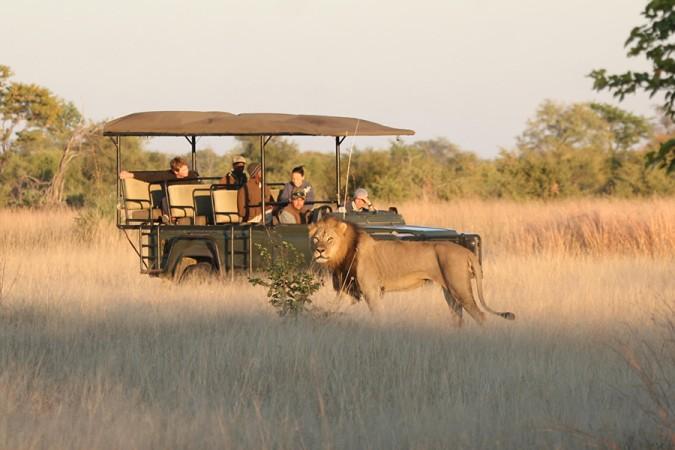
Safari Tours in Hwange National Park - © Zimbabwe Tourism
Weather in Matabeleland: Best Time to Visit
Matabeleland experiences a semi-arid climate, making it a year-round destination with distinct weather patterns that can influence travel plans.
Dry Season in Matabeleland
This is the most popular time for tourists to visit Matabeleland. During this period, the weather is mild and dry, with cool evenings and warm days. Daytime temperatures average between 20°C and 25°C, ideal for outdoor activities such as safaris and hiking in Matobo National Park.
Wet Season in Matabeleland
The wet season brings higher temperatures and afternoon thunderstorms, with average temperatures ranging from 25°C to 30°C. While some areas may experience heavy rainfall, it’s also a beautiful time to see the region's lush landscapes. Wildlife spotting in Hwange National Park can be more challenging, but it’s a great time for birdwatching.
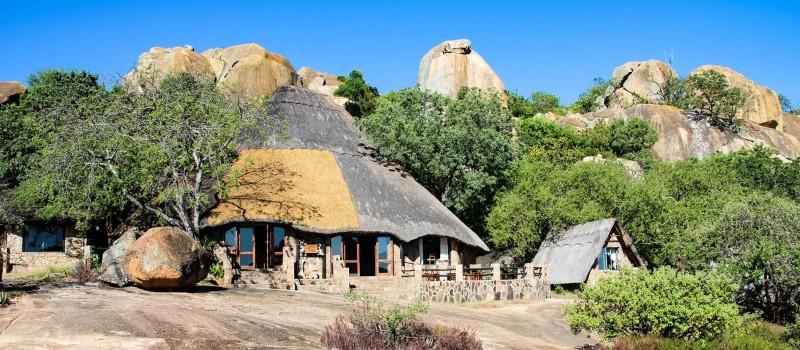
Safari camp in Matabeleland - © Facts.net
Essential Travel Information
Getting Around Matabeleland
- Public Buses: Local buses are the most affordable option for getting around towns and between cities like Bulawayo and Victoria Falls. However, they can be crowded and slow, so they may not be the most comfortable option for tourists with tight schedules.
- Minibus Taxis (Kombis): These shared minibus taxis are a popular way to travel within cities and between towns. They’re fast, inexpensive, and readily available, but they can be cramped. For shorter trips, kombis are a practical option, although they may lack the comfort and reliability of private transportation.
- Car Rentals: Renting a car is ideal for tourists who want more independence and flexibility in exploring Matabeleland, particularly for visiting attractions like Hwange National Park or Matobo Hills. Driving in Zimbabwe is on the left-hand side, and 4x4 vehicles are recommended for more remote areas, especially during the rainy season.
- Flights: For longer distances, such as traveling between Bulawayo and Victoria Falls, domestic flights are available and provide a faster alternative.
ATM & Banking Services
ATMs and banking services in Matabeleland are easily accessible in major towns, with most ATMs accepting international cards like Visa and MasterCard. However, in rural areas, ATMs can be scarce, so it's advisable to carry some cash. While Zimbabwean dollars are the official currency, US dollars are widely accepted for larger transactions, making it helpful to have small denominations on hand. Most hotels, restaurants, and tourist attractions accept credit and debit cards, though smaller markets and local shops may require cash.
Where to Stay in Matabeleland
- Hotels: Bulawayo, the region’s largest city, has a wide range of hotels, from upscale to budget-friendly. These hotels provide modern amenities such as Wi-Fi, restaurants, and comfortable rooms, catering to both leisure and business travelers.
- Safari Camps: For visitors heading to Hwange National Park, staying at a safari camp is an unforgettable experience. These lodges offer a blend of luxury and adventure, with guided safaris, scenic views, and the chance to observe wildlife directly from your accommodation.
- Guesthouses: Smaller towns and cities across Matabeleland feature cozy guesthouses and bed & breakfast options, which provide a more intimate, home-like experience. These lodgings often offer personalized service and are a great way to experience local hospitality.
- Homestays: For a truly immersive experience, some locals offer homestays, where visitors can live with a family and experience Ndebele culture firsthand. Homestays are more common in rural areas and provide a unique opportunity for cultural exchange and a deeper connection to the local way of life.
Des articles pour vous

Voyage à Kampong Cham - Cambodge, Asie
Kampong Cham est une charmante ville riveraine située le long du fleuve Mékong. Connue pour son importance historique et ses attractions culturelles, Kampong Cham offre un mélange d'architecture coloniale, de temples anciens et de paysages pittoresques. Kampong Cham est reliée au district voisin de Tbong Khmum par le pont Kizuna, le premier pont au Cambodge à traverser le fleuve Mékong, en faisant un carrefour de transport crucial pour la région.
Population : Estimation de 80 000 habitants (en 2024)
Économie : Bien que n'étant pas encore une destination touristique majeure, Kampong Cham propose des sites culturels et historiques, tels que le temple Wat Nokor et le pont en bambou de Koh Pen, ainsi que des attractions naturelles comme des forêts et des chutes d'eau. Le gouvernement se concentre sur le développement du tourisme pour améliorer l'économie locale.
Points d'intérêt : Wat Nokor Bachey, Phnom Han Chey, Phnom Pros et Phnom Srey, pont en bambou de Koh Pen, Wat Joy T'maw, Preah Theat Teuk Chha, piste d'atterrissage abandonnée de l'US.

Explorez Nha Trang - Voyage au centre du Vietnam, Asie
Nichée le long de la magnifique côte du Vietnam, Nha Trang se distingue comme une destination de premier choix pour les voyageurs. Cette ville côtière, réputée pour ses superbes plages et sa vie marine foisonnante, s'adresse à tous. Nha Trang vous accueille à bras ouverts, que vous recherchiez des aventures, de la culture ou de la détente au bord de la mer. Ce guide vous fera découvrir les points forts de cet endroit magnifique, facilitant ainsi la planification de votre voyage de manière fluide et excitante.
Population : Environ 423 000 habitants en 2019.
Économie : L'un des principaux centres touristiques du Vietnam et la plus grande économie de la province de Khanh Hoa.
Sites emblématiques : Célèbre pour les tours Cham de Po Nagar, la cathédrale de Nha Trang et l'île Hon Mun.

Voyage à Sihanoukville - Cambodge, Asie
Sihanoukville, une ville côtière du sud-ouest du Cambodge, est la capitale de la province de Preah Sihanouk. Située sur une péninsule le long du golfe de Thaïlande, la ville est bien reliée à Phnom Penh par des autoroutes principales et dispose d'un aéroport international.
La ville abrite le seul port en eau profonde du Cambodge, jouant un rôle crucial dans la logistique et le commerce du pays. Les plages magnifiques de Sihanoukville, telles qu'Ochheuteal et Serendipity, attirent aussi bien les touristes nationaux qu'internationaux. Le développement économique a prospéré ces dernières années, en particulier grâce à la création de la Zone économique spéciale de Sihanoukville (SSEZ) et aux investissements chinois dans les casinos, l'immobilier et les stations balnéaires. La ville offre également des attractions naturelles telles que le parc national de Ream et plusieurs îles voisines, en faisant une destination variée pour les voyageurs d'affaires et de loisirs.
Population : La population de Sihanoukville était d'environ 160 000 habitants en 2024.
Économie : Sihanoukville, une ville côtière en pleine croissance au Cambodge, se distingue par son mélange dynamique de développement économique et de tourisme. La Zone économique spéciale de Sihanoukville (SSEZ) est devenue un pôle industriel majeur, abritant plus de 180 entreprises et créant des milliers d'emplois. Avec le seul port en eau profonde du Cambodge, la ville joue un rôle clé dans le commerce et la logistique du pays. Bien qu'elle se soit transformée d'une petite ville balnéaire tranquille en un centre urbain animé, Sihanoukville reste célèbre pour ses plages immaculées, attirant des touristes tout au long de l'année. Les investissements chinois importants ont alimenté la croissance des hôtels, des casinos et de l'immobilier, faisant de la ville un centre d'opportunités économiques et d'hospitalité.
Monuments : Plage d'Otres, Plage d'Ochheuteal, Plage de l'Indépendance, Parc national de Ream, Chute d'eau de Kbal Chhay, Monument des Lions d'Or, Wat Leu.

Explorez Kharkhorin - Voyage en Mongolie, Asie
Bienvenue à Kharkhorin, un trésor historique niché au cœur de la Mongolie. Ancienne capitale vibrante de l'Empire Mongol sous le légendaire Gengis Khan, Kharkhorin se dresse comme un témoignage de la riche culture et de l'histoire de la Mongolie. Cette ville antique possède une combinaison unique d'importance historique et de paysages époustouflants, en faisant une destination incontournable pour un voyage de rêve en Mongolie. En mettant le pied à Kharkhorin, vous ferez un saut dans le temps, à une époque de grands palais, de routes commerciales prospères et d'échanges culturels sans pareils. Que vous soyez intrigué par les ruines anciennes, désireux d'explorer les traditions locales ou simplement en quête d'une immersion dans la beauté naturelle de la Mongolie, Kharkhorin a quelque chose à offrir à chacun.
Population : Environ 1 000 habitants en 2020.
Économie : L'une des attractions touristiques les plus importantes de la Mongolie et l'ancienne capitale de l'Empire Mongol.
Monuments : Célèbre pour les Ruines de Kharkhorin, le Monastère d'Erdene Zuu, et la Vallée d'Orkhon, un site du patrimoine mondial de l'UNESCO.

Explore Luang Prabang - Laos Travel, Asia
Luang Prabang, nestled in northern Laos at the meeting point of the Mekong river and Nam Khan river, is a city celebrated for its rich cultural heritage and stunning natural beauty. Recognized as a UNESCO World Heritage Site in 1995, it boasts a unique blend of traditional Lao and French architecture that has been carefully preserved. Whether you're wandering through its ancient temples, admiring the local architecture, or soaking in the natural beauty of waterfalls and rivers, Luang Prabang offers something for everyone.
Population: Approximately 470,000 in 2020.
Economy: Luang Prabang's economy thrives on tourism, with its UNESCO status drawing visitors to its temples, natural wonders, and cultural experiences. Local crafts, hospitality, and small businesses also play vital roles, supporting the town's sustainable growth. Local crafts, hospitality, and small businesses also play vital roles, supporting the town's sustainable growth.
Landmarks: Famous for the Wat Xieng Thong, Royal Palace Museum (also known as Haw Kham), and Mount Phousi (Phou Si Hill).Luang Prabang, nestled in northern Laos at the meeting point of the Mekong river and Nam Khan river, is a city celebrated for its rich cultural heritage and stunning natural beauty. Recognized as a UNESCO World Heritage Site in 1995, it boasts a unique blend of traditional Lao and French architecture that has been carefully preserved. Whether you're wandering through its ancient temples, admiring the local architecture, or soaking in the natural beauty of waterfalls and rivers, Luang Prabang offers something for everyone.
Population: Approximately 470,000 in 2020.
Economy: Luang Prabang's economy thrives on tourism, with its UNESCO status drawing visitors to its temples, natural wonders, and cultural experiences. Local crafts, hospitality, and small businesses also play vital roles, supporting the town's sustainable growth. Local crafts, hospitality, and small businesses also play vital roles, supporting the town's sustainable growth.
Landmarks: Famous for the Wat Xieng Thong, Royal Palace Museum (also known as Haw Kham), and Mount Phousi (Phou Si Hill).

Explore Vientiane - Laos Travel, Asia
Vientiane, the capital of Laos, offers a unique travel experience for those looking to explore a peaceful Southeast Asian city with a deep connection to its cultural roots. Unlike other bustling capitals, Vientiane boasts a serene and laid-back atmosphere, making it a perfect destination for travelers wanting to escape the chaos of more crowded cities. This charming city sits along the Mekong River, offering scenic views, rich history, and a vibrant yet tranquil way of life. As a gateway to exploring Laos, this capital invites you to slow down, immerse in its heritage, and enjoy the local flavors.
Population: Approximately 840,000 in 2023.
Economy: Vientiane's economy is growing steadily, driven by government services, trade, and tourism. Key sectors include agriculture, manufacturing, and construction. The city's strategic location along the Mekong River supports trade with neighboring Thailand and Vietnam.
Landmarks: Famous for the Pha That Luang, Patuxai, and the Buddha Park (or Wat Xieng Khuan).
